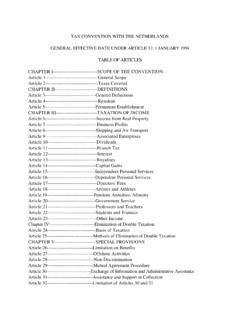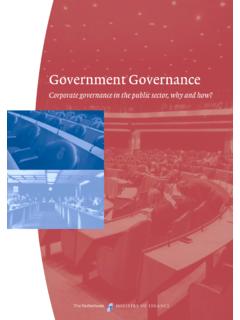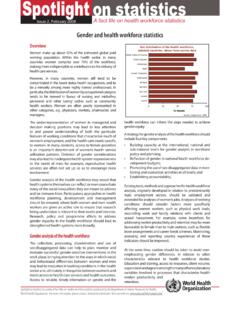Transcription of Netherlands regulatory documentation and …
1 Netherlands : regulatory documentation and country-by-country reporting requirements Oosterhoff regulatory documentation and Country-by-Country Reporting RequirementsThe Senate of the Dutch Parliament on 21 December 2015 has passed the legislative proposals that will implement country-by-country reporting in line with Action 13 of the OECD s BEPS Project. The author considers the likely impact of the coming changes and the future outlook in the IntroductionThe Senate of the Dutch Parliament has passed the legislative proposals to implement the OECD s country-by-country reporting template, master file and local file under the documentation Action of the OECD s interna-tional project to combat base erosion and profit shifting (BEPS). The changes to the Corporate Income Tax Act, 1969 (CITA) include the supplementary transfer pricing documentation requirements under the approach of Action 13 of the BEPS Project.
2 It is no surprise that the legislative proposals were originally already released on 15 September 2015, thus even prior to the release of the final BEPS action reports that were released on 5 October 2015. The Dutch government had already clearly expressed its determination to be at the forefront of transparency and information , the introduction of country-by-country reporting requirements, combined with the new docu-mentation requirements for both the master file and the local file, are major changes relative to the current docu-mentation requirements in the Netherlands not only in terms of the more detailed requirements in relation to what taxpayers must prepare, but also in terms of the proposed penalty provisions to enforce these new , in a post-BEPS environment with an unprec-edented disclosure of information, it is crucial that the intent of all governments be consistent with the OECD s objectives.
3 The author believes that countries providing a stable, reliable and predictable government response to transparency should be positioned very well to have sur-rogate parent roles. The surrogate parent role may indeed prove to be very relevant in the near The Dutch Approach: At the Forefront of Transparency and Information ExchangeThe willingness and determination of the Dutch govern-ment to truly set an example and be a leader in the field of transparency and information exchange had already been communicated prior to the release of the original legislative proposals. In a letter dated 30 August 2013, the government already emphasized the significance of inter-national coordination and explained that the government stimulates increased exchange of When the OECD, on 16 September 2014, released its first recom-mendations for a coordinated international approach to combat tax avoidance by multinational enterprises, the State Secretary for Finance also wrote a letter to the parlia-ment.
4 That letter2 explained that the government is spear-heading initiatives to modernize the network of tax trea-ties, but also that the Netherlands is very active in relation to international transparency and exchange of informa-tion. To illustrate more specifically, the letter explained how the government has been at the forefront of the devel-opment of the Common Reporting Standard, and that the Netherlands is part of a group of early adopters for imple-menting this Dutch ambitions in this area were articulated in more detail in a letter from the State Secretary for Finance on 2 June 2015. In that letter,3 the government specifically explained in which areas the government wishes to under-take the necessary initiatives to have a leading interna-tional role. There are three areas in particular where the government has the ambition to play a leading interna-tional role: transparency: exchange of information and sharing rulings; transfer pricing; and developing countries: modernizing tax treaties and support in building the required capabilities or tech-nical significance of these topics, along with the dedication and underlying commitment from the government, was emphasized when the State Secretary for Finance com-mented on the outcome of the BEPS Project and the view-points of the Dutch cabinet on the BEPS initiatives.
5 In this l e t t e r,4 the government explained the importance of the BEPS initiatives, and noted that the government embraces this and acknowledges that in certain areas, national rules may need to be adopted for greater international See Kamerstukken II 2013/14, 25087, NL: Letter from the State Secretary for Finance, IZV/2014/439 M2, 16 Sept. NL: Letter from the State Secretary for Finance, IZV/2015/4-314 U, 2 NL: Letter from the State Secretary for Finance, IZV/2015/657 M, 5 Oct. Oosterho *Netherlands75 IBFD INTERNATIONAL TRANSFER PRICING JOURNAL JANUARY/FEBRUARY 2016* Partner, EY, Transfer Pricing & Operating Model Effectiveness, Amsterdam. The opinions expressed in this article are those of the author and not necessarily those of the The Dutch investment climateThe above-mentioned letter also discusses the Dutch investment climate, emphasizing that the tax system has always had an international focus.
6 The level playing field and the international treaty network that extends to nearly 100 tax treaties all contribute to a stable and reliable system. Another significant factor that contributes to sta-bility is the manner in which the tax authorities work, with a focus on consistency, transparency and a pragmatic atti-tude towards resolving issues considering the Dutch law, jurisprudence and policies. The opportunities for obtain-ing certainty upfront through advance tax rulings and advance pricing agreements (APAs) fit within that overall model. Furthermore, the letter also explains that the Dutch tax authorities have developed excellent relationships with tax authorities of many different countries. In particular, this is also relevant in relation to so-called mutual agree-ment procedures. The government has been success-ful in resolving many mutual agreement procedures in a very satisfactory manner, and is increasingly concluding bilateral APAs.
7 This avoids double taxation and provides for (bilateral) certainty for companies. The government wishes to continue to foster these good relationships and to actively seek how these international relationships can be further it may not have been specifically articulated in the letter, there is certainly a strong belief that, in a post-BEPS world, it is critical to have a strong, reliable govern-ment that will have a consistent, transparent and prag-matic approach to information exchange, and the same approach regarding international dialogue about the information that will be exchanged. All the new transpar-ency measures, coupled with the new guidance regard-ing the application of the arm s length principle, could trigger much more debate concerning transfer pricing, and diverging interpretations will continue to emerge. There-fore, it can certainly be understood and appreciated that the government considers that spearheading transparency and exchange of information will actually be a significant foundation of the attractiveness of the Dutch investment climate.
8 In a world where there could be much more (in-ternational) controversy on the horizon, having a reliable government where consistency, transparency and prag-matism go hand in hand will be a vital feature for multi-national enterprises seeking certainty in a world of many (lingering) uncertainties. The value of the predictability of a country s position in mutual agreement procedures cannot be underestimated, and such a stable environment can exist only when countries truly apply the same prin-ciples consistently in both inbound and outbound , there is an inherent belief that acting as a leader in the realms of transparency and information exchange can be a key feature in contributing to a strong investment The new legislationIt was never expected that the Dutch legislation imple-menting the BEPS Action 13 standards, would be substan-tially different to what is included in the Action 13 Final Thus, the underlying premise of the adopted leg-islation is that it effectively includes a requirement that multinational groups provide all relevant governments with needed information on their global allocation of income.
9 Economic activity and taxes paid among coun-tries. Thus, the new legislation embraces the three-tiered standardized approach to transfer pricing and encom-passes the following framework: multinational groups are required to provide all rel-evant tax administrations with high-level informa-tion regarding their global business operations and transfer pricing policies in a master le; local group companies are required to have detailed transactional transfer pricing documentation pro-vided in a local le that is speci c to each country, identifying material related-party transactions, the amounts involved in those transactions and the company s analysis of the transfer pricing determi-nations they have made with regard to those trans-actions; and large multinational groups are required to le a coun-try-by-country report that will provide, for each tax jurisdiction in which they do business, the amount of revenue; pro t before income tax; and income tax paid and accrued, on an annual basis.
10 It also requires multinational groups to report their number of em-ployees, stated capital, retained earnings and tangible assets in each tax jurisdiction. e report must also identify each group entity doing business in a partic-ular tax jurisdiction and to provide an indication of the business activities in which each entity is new legislation regarding the changed documentation requirements (including the master file, local file and the newly introduced country-by-country reporting for fiscal years starting on or after 1 January 2016) is founded on the premise that this should facilitate a more efficient risk selection process for transfer pricing. In cases where this risk selection process indicates high risks, the relevant tax authorities can request more information and perform a more thorough assessment. This should provide for the more effective use of scarce resources to work on combat-ing base erosion and profit shifting.















